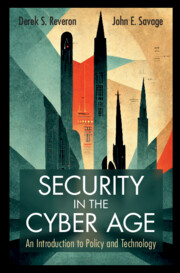Book contents
- Security in the Cyber Age
- Reviews
- Security in the Cyber Age
- Copyright page
- Epigraph
- Contents
- Boxes
- Preface
- Acknowledgments
- Introduction
- 1 The Emergence of Cyberspace and Its Implications
- 2 From the Abacus to the Computer
- 3 Communicating through Cyberspace
- 4 The Human Dimensions of Cyberspace
- 5 Strategy and Cyberspace
- 6 Domestic Regulation of Cyberspace
- 7 Internet Governance and International Institutions
- 8 International Law and Norms in Cyberspace
- 9 Artificial Intelligence and Ethics
- 10 Conclusions and Future Directions of Cybersecurity Policy
- 11 Leading in the Cyber Age
- Glossary
- References
- Index
10 - Conclusions and Future Directions of Cybersecurity Policy
Published online by Cambridge University Press: 02 November 2023
- Security in the Cyber Age
- Reviews
- Security in the Cyber Age
- Copyright page
- Epigraph
- Contents
- Boxes
- Preface
- Acknowledgments
- Introduction
- 1 The Emergence of Cyberspace and Its Implications
- 2 From the Abacus to the Computer
- 3 Communicating through Cyberspace
- 4 The Human Dimensions of Cyberspace
- 5 Strategy and Cyberspace
- 6 Domestic Regulation of Cyberspace
- 7 Internet Governance and International Institutions
- 8 International Law and Norms in Cyberspace
- 9 Artificial Intelligence and Ethics
- 10 Conclusions and Future Directions of Cybersecurity Policy
- 11 Leading in the Cyber Age
- Glossary
- References
- Index
Summary
Chapter 10 draws conclusions and proposes ways to improve security in cyberspace. As the preceding chapters make clear, information and communications technology is the latest tool humans developed that has widespread impact on economic and social development on earth and will be critical as humans start to setup colonies in the solar system. Just like other tools, information technology holds both the promise of a better future and the prospect for increasing misery unless digital divides narrow and people adapt to new economic realities brought about by technological change. Engineering and scientific principles underlie the Internet, and we cannot overlook that humans write code, develop algorithms, and manufacture the hardware that create cyberspace with all its benefits and risks. To structure thinking about the future directions of cybersecurity, we propose three questions. First, whose Internet is it? Next, how should we think about cybersecurity? The final question is, what role should governments play in responding to significant cyber events?
- Type
- Chapter
- Information
- Security in the Cyber AgeAn Introduction to Policy and Technology, pp. 295 - 320Publisher: Cambridge University PressPrint publication year: 2023

